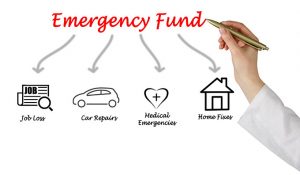Your future is unpredictable. The old adage, ‘It’s better to be safe than sorry’, is becoming more evident every day with unexpected weather conditions, vehicular accidents and medical emergencies. We never know what the future may hold, so it’s always best to be prepared. Many financial planners and investment advisers will recommend establishing an emergency fund for you and your family. It should ideally be one of your highest savings priorities.
These five tips will help you set goals and take steps toward starting an emergency fund.
Tip 1 – Chart your monthly income and expenses. Write down how much money comes in and goes out in expenses every month. Be sure to include recurring expenses such as your rent or mortgage, utility bills and childcare, and estimates of other out-of-pocket expenses for things you might buy such as movie tickets, lunch or dinner and clothing.
Tip 2 – Set your emergency savings goal. An emergency fund should cover three to six months’ worth of realistic living expenses. If you believe your income is stable or have some form of credit to offset costs, you may be able to set a lower figure.
Tip 3 – Develop a plan to start saving. Setting a goal and developing a plan to achieve those goals go hand-in-hand. Part of your plan may include specific and measurable targets to work toward. For example, one specific goal may be to save an extra $200 each month to put into an emergency fund.
Tip 4 – Put your emergency fund in an accessible place. The best place for your emergency fund is in a liquid account (an account where your cash is easily accessible). A liquid account might be a regular savings account at a bank or credit union that provides some return on your deposit and from which your funds can be withdrawn at any time without penalty. Be sure to check the charges to these accounts before you engage in opening such accounts. If you consider other options, like a certificate of deposit, a money market fund or mutual fund, be sure to figure out how accessible your money will be in an emergency.
Tip 5 – Stick to your plan. Once you’ve created your plan, make sure you stick to it. This can sometimes be the hardest part of saving for an emergency fund or any financial goal in general. If your goals are realistic and attainable, sticking to the plan will be much easier. A good way to stay on track is to save automatically. Set up a systematic transfer from your regular chequing or savings accounts at your bank or credit union. Be sure to keep your rainy day funds separate from your other accounts, and label it “for emergency use only.” Just writing down an account’s purpose can keep you from spending the money for any other reason.
Starting an emergency fund is a necessary building block for long-term financial stability.
Anyone can do it; you just need the right goals and a plan!
Adapted from: https://www.saveandinvest.org/military-everyday-finances/start-emergency-fund




